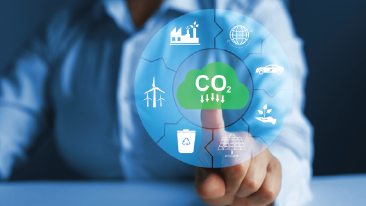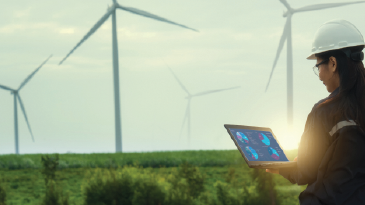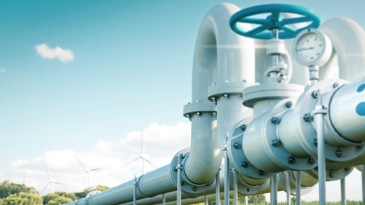Carbon Capture and Storage (CCS) has gained phenomenal momentum in the past 24 months. Projects have been announced almost weekly and, according to two surveys recently conducted by AspenTech, indicate that for asset-intensive companies (such as oil and gas, chemicals and metals), carbon capture has risen to the top of the capital investment area globally.
Yet, carbon capture still faces stiff hurdles in order to achieve its expected global impact — carbon capture and storage are often heavy expenditures. According to a 2021 International Energy Agency (IEA) analysis, the current cost of capture for industrial flue-gas streams is between $15 and $25 USD per ton and, the cost of direct air capture ranges from $132 to $342 USD per ton. Additionally, the subsurface injection and storage costs vary widely by reservoir situation and range, from around $6 to $60 USD per ton.
As we have seen, in the areas of solar photovoltaics and wind turbines, scale and market demand can be big drivers themselves to improve economics. However, in the area of carbon capture it’s not that simple. Technology innovation will continue to be crucial. Digital technology is and will be a key enabler of both innovation and scaling of carbon capture.
Today, digital technology is being used to optimize the performance and economics of CCS. For instance, point source and direct air capture have been constantly innovated by organizations such as EPC Fluor, direct air capture leaders Carbon Engineering and Carbon Capture Inc, process technology and solvent innovators Shell CANSOLV and Dow, the consortium, Technology Center Mongstad as well as new industry players Carbon Collectors NV and research group National Renewable Energy Laboratory (NREL). None of these players could have made the rapid progress in improving processes, reducing economic uncertainty nor accelerating engineering and scaleup without digital solutions such as AspenTech’s Aspen Plus®, Aspen HYSYS®-based dynamic modeling and operator training or the accompanying end-to-end digital twin workflows.
“The recent advances in technology offer ground-breaking opportunities to monitor and protect the environment, as well as overall planetary health. By harnessing these appropriately, the digital revolution can be steered to advance global sustainability, environmental stewardship and human well-being.”
— United Nations Digital Environmental Sustainability Initiative
What are the key digital drivers making carbon capture realistic in solving carbon removal challenges?
- Evaluation of the Subsurface for Suitability as CO2 Sequestration Sites
Many candidate locations are depleted oil and gas production reservoirs. Existing data, of which much is available, can be used to fuel advanced modeling tools to assess suitability as CO2 storage sites, lifecycle economics of injecting and storing the CO2, and confidence that the CO2 will stay where it is placed for 100 years or more. A major National Oil Company (NOC) has used AspenTech’s integrated subsurface science and engineering software to assess and economically rank their hydrocarbon reserves as candidate sequestration sites.
- Selecting Suitable Carbon Capture Technology with Systems-Level Optioneering
Selection of the right carbon capture technology, and the right energy sources driving that capture, involves a complex set of options, depending on the scope and scale of an emitter and its interaction over a value chain. Our Aspen FidelisTM risk analysis system is ideal for evaluating carbon capture hub proposals. Research organizations such as National Energy Technology Lab (NETL) and MIT Energy Lab (SESAME project) are very effectively using AspenTechs’s simulation modeling tools for large scale optionality and impact analysis for carbon capture approaches.
- Digital Twin Modeling of Carbon Capture Systems.
From solvent performance, to column configurations and rating, to energy optimization, to integration of renewables with capture modules, digital twins are fundament to the rapid innovation and improvements that have marked the carbon capture arena in the past few years. Digital twins, typically a “nice to have” in conventional processes, are absolutely essential for the insights needed for operational performance and the feedback required for the improvements and innovations that come from operational analytics and models.
AspenTech introduced patented rate-based models for carbon capture 15 years ago and our models continue to play a central role in leading carbon capture innovators such as Carbon Engineering, Svante, Carbon Capture Inc, Cansolv, Carbon Collectors, and Technology Centre Mongstad. Several of these technology innovators are now applying dynamic modeling to train operators.
- Situational Awareness and Decision Support for Carbon Reduction
Carbon capture programs create results and value in the context of an enterprise’s journey towards zero carbon. To fully understand where and how to apply carbon capture systems, much more sophisticated situational awareness and detailed understanding of the “bad actors” is needed within a facility that require priority investment in carbon capture solutions. This involves orchestrating the same key underlying systems that designed carbon capture systems to provide decisions support optionality to meet carbon mitigation targets, to improve CCS economic performance, and to provide transparent auditing to stakeholders. Digital technology will answer the company’s questions about where to apply capital resources and investors’ questions about progress towards net zero commitments.
- Digital Optimization Solutions
Digital optimization solutions such as AI-assisted advanced process control will play a key role in getting the best possible removal of CO2 from both “high purity” CO2 emissions as well as from low concentration CO2 stream and ambient air. Economic penalties in carbon capture come from energy use in the processes, fans used to move air in direct air capture, inefficiencies in the renewable energy resources grids, CO2 supercooling and transport, and the injection systems for sequestration. All of these can be greatly enhanced with digital optimization solutions such as AspenTech’s advanced process control (Aspen DMC3TM), distributed energy resource management systems (OSI DERMS), and other optimization models.
- Geological and Geophysical Modeling for Monitoring Storage
To satisfy the financial community, governments and society, CO2 which has been sequestered for long term subsurface storage must be monitored in the long term. Long term monitoring strategies are still being developed. For CO2 injected into depleted hydrocarbon reservoirs and into saline aquifers, data collection combined with modeling and analysis will provide confidence that CO2 remains in place and that the overlying rock formations remain intact. Seismic monitoring feeding interpretation models will provide early warning of any changes in the integrity of the rock formations and direct and indirect monitoring devices combined with reservoir and process models will provide a digital twin of the stored CO2.
Our recent on-demand webinars provide more ideas on how you can partner with AspenTech to achieve your sustainability goals faster, smarter, all while supporting improved operational excellence.
When you’re ready to get started, AspenTech provides an application library of more than 60 out-of-the-box sustainability sample models to accelerate your adoption of digital technologies in support of carbon capture and storage.
.png?h=250&w=975&la=ja&hash=60082972635D3D3B81B62609A5E2F213)





Leave A Comment